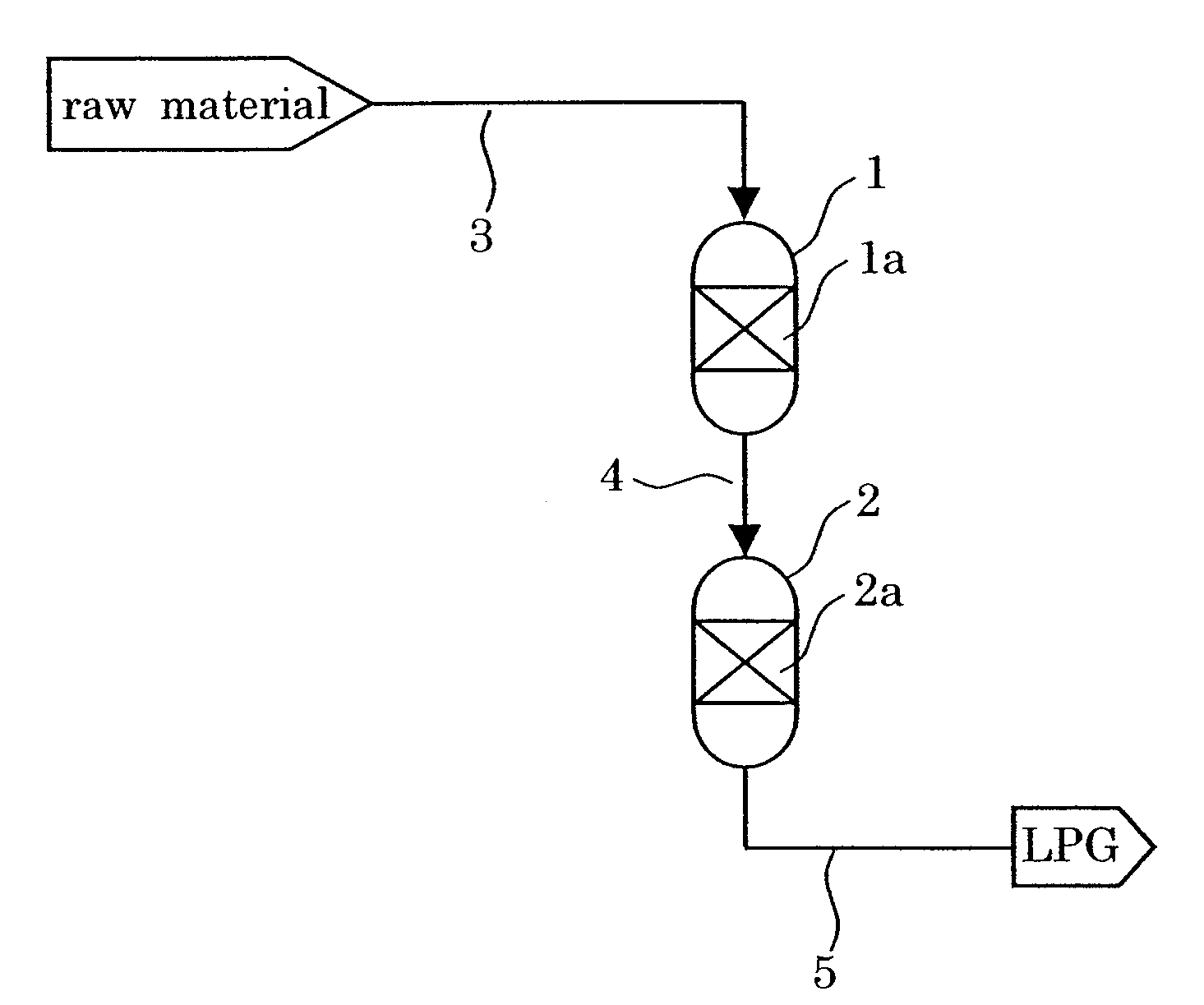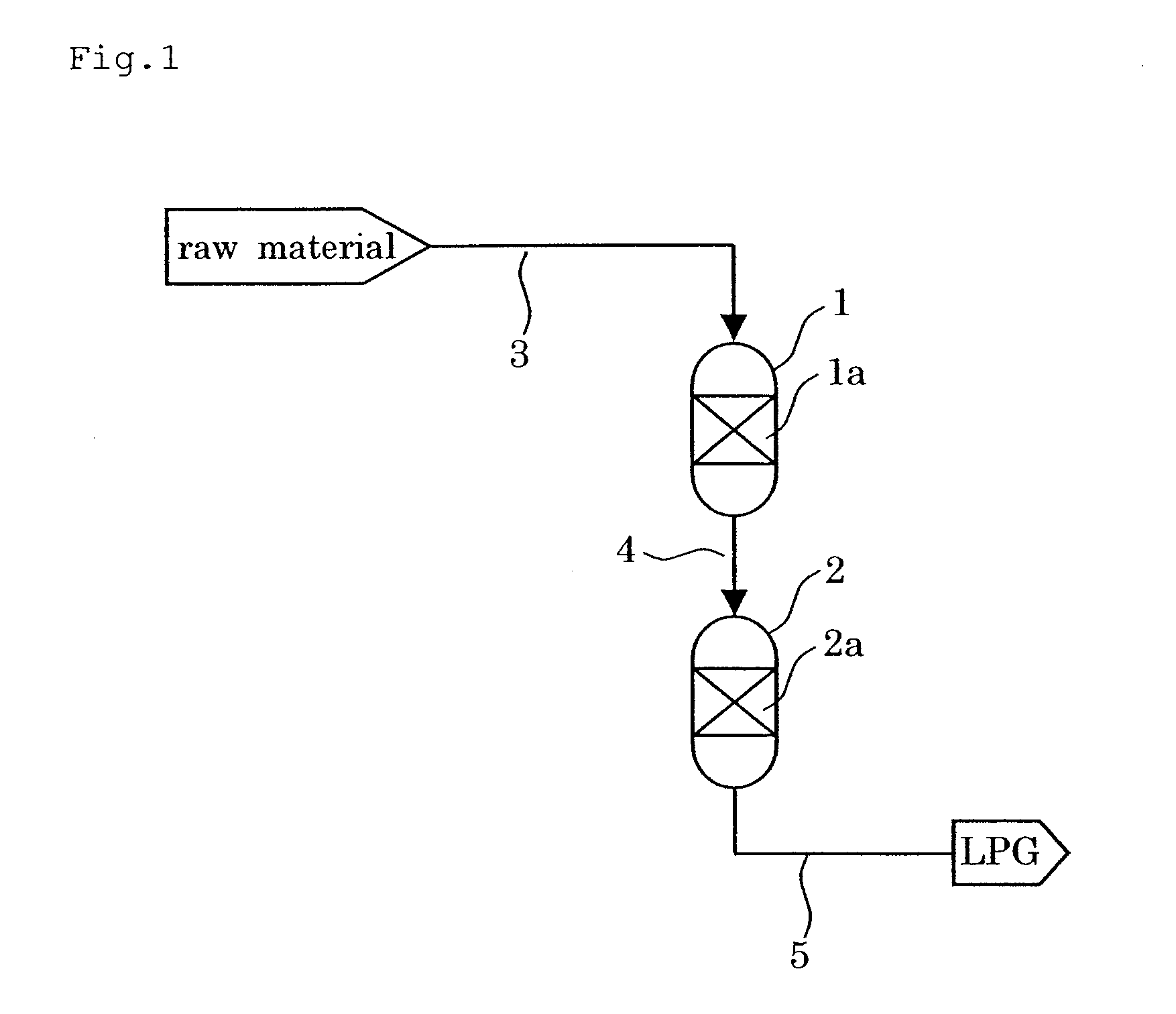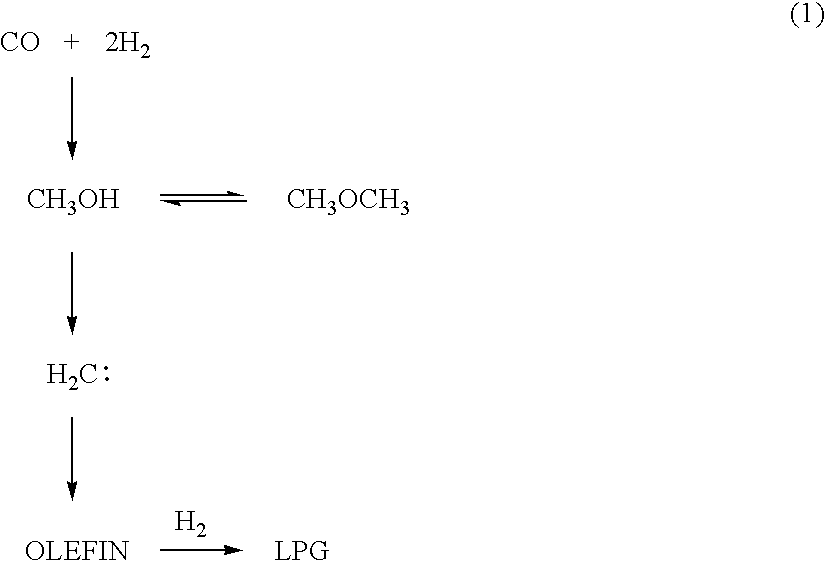Catalyst and Process for Producing Liquefied Petroleum Gas
a technology of liquefied petroleum gas and catalyst, which is applied in the direction of physical/chemical process catalyst, hydrocarbon oil treatment product, metal/metal-oxide/metal-hydroxide catalyst, etc. it can solve the problems of insufficient performance particularly in terms of hydrocarbon activity and yield, insufficient performance of hydrocarbon, and large use of high-priced pd, etc. , to achieve the effect of high selectivity, high yield and high activity
- Summary
- Abstract
- Description
- Claims
- Application Information
AI Technical Summary
Benefits of technology
Problems solved by technology
Method used
Image
Examples
example 1
Preparation of a Catalyst
[0202]A mechanically powdered catalyst in which 1 wt % of Pd was supported on Zn—Cr-based methanol synthesis catalyst (also referred to as “Pd / Zn—Cr”; average particle size: 0.7 μm) was used as a methanol synthesis catalyst component. The catalyst was prepared as follows.
[0203]The Zn—Cr-based methanol synthesis catalyst used was KMA (trade name), produced by Süd-Chemie Catalysts Japan, Inc. (average particle size: about 1 mm). The composition of the Zn—Cr-based methanol synthesis catalyst is Zn / Cr=2 (atomic ratio).
[0204]First, to 4.4 mL of an aqueous solution of Pd(NH3)2(NO3)2 (Pd content: 4.558 wt %) was added 1 mL of ion-exchanged water, to obtain a Pd-containing solution. 20 g of the Zn—Cr-based methanol synthesis catalyst was added to the obtained Pd-containing solution, and impregnated with the Pd-containing solution. And then, the Zn—Cr-based methanol synthesis catalyst impregnated with the Pd-containing solution was dried in a drying oven at 120° C. f...
example 2
Preparation of a Catalyst
[0211]A catalyst was prepared in the same way as Example 1, except that a methanol synthesis catalyst component and a zeolite catalyst component were separately molded by a tablet-compression to be a granule having an average particle size of 1 mm, without mechanically pulverizing, and then these components were mixed.
[0212](Production of LPG)
[0213]Using the prepared catalyst, the LPG production reaction was carried out in the same way as Example 1. Gas chromatographic analysis of the product indicated that, after three hours from the beginning of the reaction, a conversion of carbon monoxide was 86.1%, a shift reaction conversion of carbon monoxide to carbon dioxide was 33.4%, and a conversion of carbon monoxide to a hydrocarbon was 52.7%. The produced hydrocarbon gas contained propane and butane in 81.8% on the basis of carbon, which consisted of 57.5% of propane and 42.5% of butane on the basis of carbon. And, after five hours from the beginning of the re...
example 3
Preparation of a Catalyst
[0228]A catalyst was prepared in the same way as Comparative Example 2, except that 0.5 wt % of Pd was supported on a Zn—Cr-based methanol synthesis catalyst (KMA (trade name), produced by Süd-Chemie Catalysts Japan, Inc.), and the obtained 0.5 wt % Pd-supported Zn—Cr-based methanol synthesis catalyst was used as a methanol synthesis catalyst component.
[0229](Production of LPG)
[0230]Using the prepared catalyst, the LPG production reaction was carried out in the same way as Comparative Example 2. Gas chromatographic analysis of the product indicated that, after three hours from the beginning of the reaction, a conversion of carbon monoxide was 33.9%, a shift reaction conversion of carbon monoxide to carbon dioxide was 13.3%, and a conversion of carbon monoxide to a hydrocarbon was 20.6%. The produced hydrocarbon gas contained propane and butane in 80.2% on the basis of carbon, which consisted of 60.2% of propane and 39.8% of butane on the basis of carbon.
[023...
PUM
| Property | Measurement | Unit |
|---|---|---|
| molar ratio | aaaaa | aaaaa |
| temperature | aaaaa | aaaaa |
| pressure | aaaaa | aaaaa |
Abstract
Description
Claims
Application Information
 Login to View More
Login to View More - R&D
- Intellectual Property
- Life Sciences
- Materials
- Tech Scout
- Unparalleled Data Quality
- Higher Quality Content
- 60% Fewer Hallucinations
Browse by: Latest US Patents, China's latest patents, Technical Efficacy Thesaurus, Application Domain, Technology Topic, Popular Technical Reports.
© 2025 PatSnap. All rights reserved.Legal|Privacy policy|Modern Slavery Act Transparency Statement|Sitemap|About US| Contact US: help@patsnap.com



